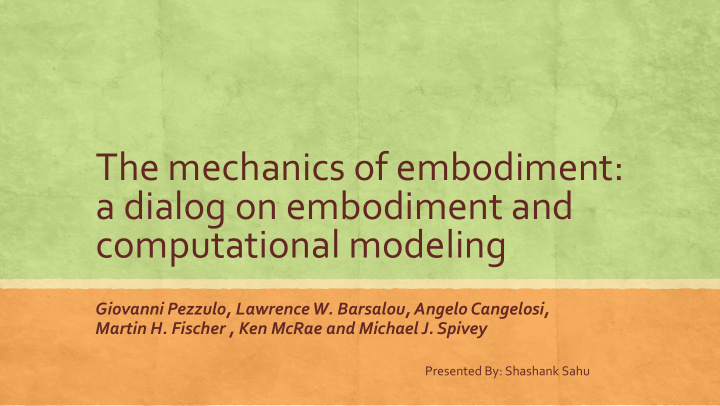



The mechanics of embodiment: a dialog on embodiment and computational modeling Giovanni Pezzulo, Lawrence W. Barsalou, Angelo Cangelosi, Martin H. Fischer , Ken McRae and Michael J. Spivey Presented By: Shashank Sahu
Cognition The mental action or process of acquiring knowledge through thought, experience, and the senses Cognitive Process includes: 1. Memory 2. Reasoning 3. Language Understanding
Three Types of Cognition • Constrained by Physical principles • Grounded in physical properties of world Grounded Cognition • Shaped by sensory motor interaction • Constrained by individuals body Embodied Cognition • It is context dependent • Changing context may be reflected in performance Situated Cognition
Postulate Sensory and motor experiences are essential for the conceptual representation that constitute our knowledge. Basis: 1. Changes in perceptual or motor behavior as a result of semantic processing 2. Changes in categorization that reflect sensory and motor experience
Qualification of “Embodied” Computational Model ▪ Should have Module dependence ▪ Cognition process shouldn't be divorced from sensory motor processes ▪ Implementation of Modal Representation ▪ Multiple Modalities are necessary
Difficulties in creating such model ▪ A hierarchical structure of modal ▪ Integration of information from different senses ▪ Modalities seems to have hierarchical structure than flat ▪ Convergence zone is required
Conclusion Authors have highlighted the most important components and processes that such models should include, how the synthetic methodology could help research in embodied cognition, and proposed six challenges for modelers. Our hope is that, in 5 or 10 years, we will see another special issue on “Embodied and grounded cognition” that describes success stories in tackling these challenges, and that in turn this progress will inspire novel and more complete cognitive theories, and ultimately a novel paradigm for (individual and social) cognition that has grounding, embodiment, and situatedness at its heart.
References ▪ Damasio, 1989;Simmons and Barsalou, 2003 ▪ Searle, J. (1980). Minds, brains and programs Behav. Brain Sci. 3, 417 – 457. ▪ Harnad, S. (1990). The symbol grounding problem. Physica D 42, 335 – 346. ▪ Myachykov, A., Platenburg, W., and Fischer, M. H. (2009). Nonabstractness as mental simulation in the representation of number. Behav. Brain Sci. 32, 343 – 344.
Thank You
Recommend
More recommend